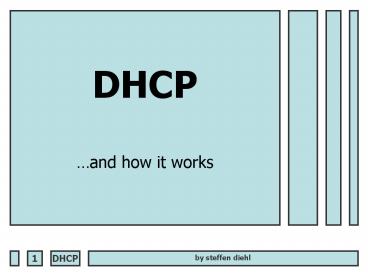DHCP - PowerPoint PPT Presentation
1 / 20
Title:
DHCP
Description:
network configuration parameters (Subnet Mask, Default Gateway, DNS and WINS) Need replacement! ... hosts coming and going with a great amount of frequency ... – PowerPoint PPT presentation
Number of Views:134
Avg rating:3.0/5.0
Title: DHCP
1
DHCP
- and how it works
2
Overview
- Introduction
- Basics
- Case - We play DHCP Server
- Problems
- Tasks
- Solutions
- Apply what you've learned
- Conclusion
3
Basics
- Dynamic Host Configuration Protocol
- Standard protocol
- Defined by RFC 1541 (superseded by RFC 2131)
- Created by the
- Host Configuration Working Group
- of the
- Internet Engineering Task Force (IETF)
4
Basics
- Runs over UDP
- Utilizing ports
- 67 connections to server
- 68 connections to client
- Extension of BOOTP (protocol used for simple
interaction) - Uses clientserver model
5
Case
- Got a network
- Want to add new clients
- DHCP-Server doesnt work
- How do clients get their
- IP Address -or-
- network configuration parameters (Subnet Mask,
Default Gateway, DNS and WINS) - Need replacement!!
6
Case - Theory
- 1st implementation goal of a DHCP Server
- support of dynamic allocation of Network
Addresses - chooses and allocates an IP address
- gives network configuration parameters to the
client
7
Case - Theory
- Need 2 databases
- Address Pool is the database which holds IP
addresses and other network configuration
parameters - Binding database keeps mapping between an
Ethernet address and Address Pool entries
8
Case - Theory
- All interactions are initiated by a client
- Server only replies
- obtain an IP address automatically in NW
options - configuring the host to the network is done by a
simple handshake
9
Case in practice
- Client broadcasts DHCPDISCOVER
- One or more servers return DHCPOFFER with
available Address and NW Information - Clients chooses one offer that it likes best
- broadcasts DHCPREQUEST to identify chosen
Server/lease - DHCPREQUEST also to renew lease
10
Case - in practice
- Server sends
- DHCPACK
- Lease is finalized
- Client starts using IP
- DHCPNAK
- Client resumes from DHCPDISCOVER point
- If client doesnt want IP - DHCPDECLINE is sent
- DHCPRELEASE gives IP back into pool
11
Case - Theory
- Static/Manual allocation
- Server allocates IP chosen by the Admin
- Server configuration includes
- IP-Address -and-
- MAC-Address
- for every client
- DHCP only used to convey assigned address to
client
12
Case - Theory
- Automatic allocation
- IP address is permanently associated with a MAC
address - till administrator intervenes the infinite lease
- Dynamic allocation
- Like Automatic allocation
- Except
- server tracks leases
- give IP addresses whose lease has expired to
other DHCP clients
end
13
Case - Theory
- Client is responsible to renew/release IP
- Lease timestamps
- Total lease duration
- T1 (0.5 duration_of_lease)
- client enters the RENEWING state
- contacts the server that originally issued
network address - T2 (0.875 duration_of_lease)
- client enters the REBINDING state
- attempts to contact any server
14
Case - Theory
- Lease duration
- Client holds IP when not connected
- Clients retire
- Servers/Databases should have constant IPs
- Analyze the NW
- Often changing clients?
- Servers/databases?
- Enough IP Addresses available?
15
Case - Theory
- By using the fitting Methods
- implementation goals 2-4 of a DHCP Server
- server should be able to recycle the IP address
when the lease period is expired - A network administrator should not configure each
client/user interaction of each client should not
be required. - support of static allocation and an infinite
lease - can also be realized!!!!
16
Case - in practice
- Servers
- WEB-Server 192.168.1.1
- Access Point 192.168.1.2
- Lecturers via Ethernet
- Range from .100 to .102
- Students via WLAN
- Range from .200 to .230
back
17
Conclusion
- Insecurity of UDP
- Broadcast of messages
- Risk of wrong configuration causing
- High traffic
- Waste of IP Addresses
- A lot more work than expected
- Detailed and precise analysis before
implementation needed
18
Conclusion
- works well if you have to manage a lot of mobile
users - people with laptops working in and out of the
office - hosts coming and going with a great amount of
frequency - perfect when Network parameters have changed
- only one point you have to work at
- sharing a limited pool of IP addresses
- Mixture of allocation types can be used
19
Conclusion
- Thank you for your attention
- any questions??
20
Refrences
- RFC 2131, Dynamic Host Configuration Protocol
- RFC 2322, Management of IP numbers by peg-dhcp
- www.ietf.org, Internet Engineering Task Force
- www.microsoft.com, Microsoft Knowledge Base
Article - 169289































